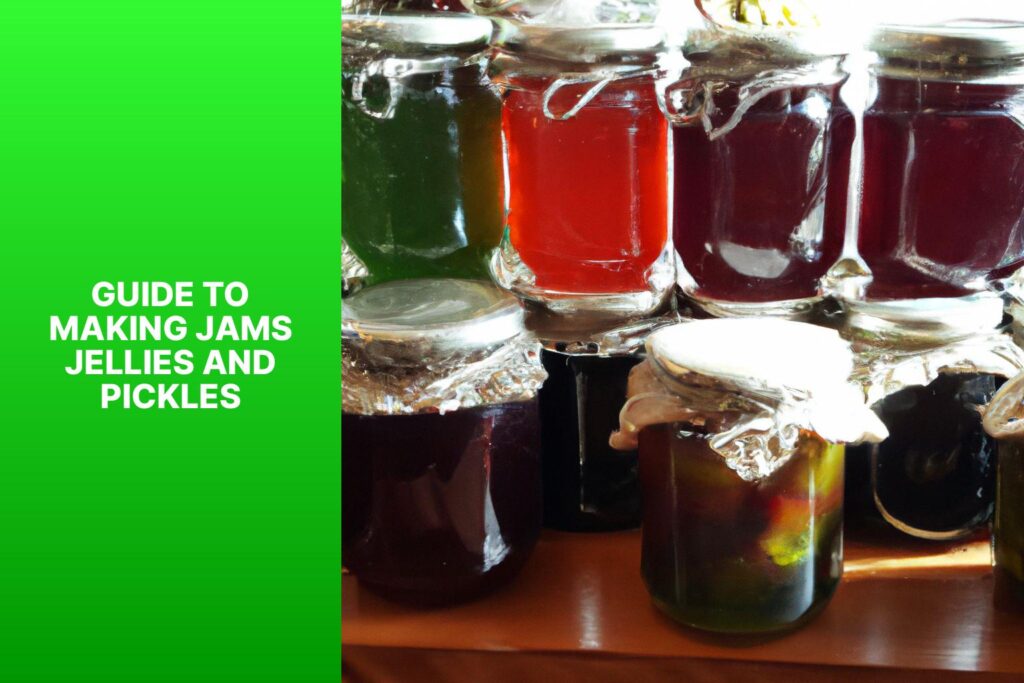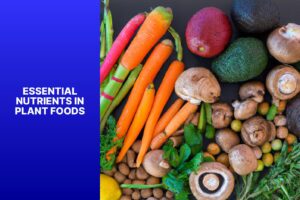Love to get creative in the kitchen? Have a thing for homemade jams, jellies & pickles? Then this guide is for you!
From novice chefs to experienced cooks, here’s all you need to know to become a master preserver.
We’ll teach you the timeless traditions of preserving fruits & veggies. Plus, get ready to experiment with flavors & combinations that tantalize your taste buds.
Jalapeno jellies, bread-and-butter pickles – there are endless possibilities!
Plus, local farmers will thank you too. By using locally sourced ingredients, you’ll be supporting small-scale agriculture & sustainable food practices.
So grab your apron & ingredients & let’s get started on your journey to becoming a master preserver!
If you want to learn methods for preserving your favorite Fruits and Vegetables in other ways, check out our article “Techniques for Preserving Fruits and Vegetables” as well!
Types of Jams, Jellies, and Pickles
Strawberry Jam: Sweet and plump strawberries make this classic jam a crowd-pleaser. Its vibrant red color and luscious taste will brighten up your breakfast table.
Raspberry Jelly: Bold and tangy flavor makes raspberry jelly the perfect zesty twist for morning toast or scones. Its smooth texture and intense fruitiness is ideal for any occasion.
Spicy Pickled Jalapeños: Add some heat to your pickling adventures with these spicy jalapeños! The perfect blend of spiciness and acidity is great for sandwiches or tacos.
Apple Cinnamon Jelly: Enjoy the comforting aroma of apple and warm cinnamon in this jelly. Spread it on freshly baked bread for a delicious snack.
Bread and Butter Pickles: Thinly sliced cucumbers pickled in a sweet and tangy brine are a classic addition to any sandwich or burger. Crispy texture and balanced flavors will leave you wanting more.
Apricot Jam: Juicy apricots create a unique combination of sweetness and tartness. Enjoy it with cheese or on toast for a burst of fruity goodness.
Dill Pickles: Crunchy, tangy, and oh-so-satisfying, dill pickles are the go-to choice for pickle enthusiasts. Their refreshing flavor is great for burgers or salads.
To make the most out of your jams, jellies, and pickles:
- Experiment with flavors. Get creative in the kitchen. Try combining different fruits or adding spices. Let your taste buds guide you.
- Proper sterilization. Ensure the longevity of your creations by properly sterilizing the jars before preserving.
- Varied presentation. Dress up your creations with cute mason jars, decorative tags, or gifting.
- Storage tips. Store in a cool and dark place. Refrigerate opened jars to preserve their flavors and textures.
Embark on a culinary adventure and transform ordinary fruits and vegetables into delectable jams, jellies, and pickles to impress everyone.
Getting Started
Grab only fresh produce to make your jams, jellies, and pickles. Look for firm and ripe ingredients with no blemishes. To get the best taste, quality matters!
Before starting, prepare your gear. Sterilize utensils and jars in boiling water or with a dishwasher cycle. This blocks contamination and extends the shelf life of your homemade treats.
Choose a recipe that fits your liking and skill level. Whether it’s tangy pickles or sweet jam, pay attention to instructions for the proper outcome.
Remember:
- High-quality ingredients bring superior flavor.
- Sterilize jars and equipment.
- Follow the recipe.
Pro Tip: Get creative and mix flavors or add herbs and spices to make unique preserves. Enjoy your yummy journey!
The Cooking Process
Steps:
- Wash and peel your chosen fruits or veggies, then get rid of any unwanted seeds or pits.
- Chop the ingredients into small, even pieces.
- Put them in a big pot and cover with water or juice.
- Turn the heat to medium and let it come to a gentle boil.
- Lower the temperature and simmer for the necessary time to let the flavors blend together.
- Skim off any foam that rises with a spoon or strainer.
- Use a canning funnel and ladle to carefully transfer the hot mixture into sterilized jars.
- Seal them securely with lids and follow proper canning guidelines.
Refer to recipe sources such as “The Complete Book of Home Preserving” for accurate measurements and techniques. Remember, different fruits or vegetables might need different amounts of acid or sugar.
If you want to learn methods for preserving your favorite Fruits and Vegetables in other ways, check out our article “Techniques for Preserving Fruits and Vegetables” as well!
Did you know pickling has been used for food preservation for thousands of years? The Mesopotamians were known to love pickled foods!
Troubleshooting Tips
Troubleshooting Tips:
Having trouble with your homemade jams, jellies, or pickles? Read on for expert advice!
Guide to Troubleshooting:
- Texture Problems: If your jam is runny or your pickles are soft, the issue may be insufficient pectin. Try using underripe fruits or adding commercial pectin.
- Spoilage Prevention: Sterilize canning jars and lids before use. Seal and store in a cool, dark place.
- Color Concerns: To prevent discoloration of jams and jellies, don’t overcook them. Follow recipe instructions closely and process for the right amount of time.
Additional Tips:
- Ensure proper acidity levels in pickles by using vinegar with 5% acidity or more.
- Low-acid veggies might need extra lemon juice or vinegar.
Historical Insight:
People have been making jams, jellies, and pickles for centuries to preserve foods beyond their peak season. Ancient civilizations relied on these techniques for survival. Now, these traditional culinary techniques still captivate our taste buds and preserve nature’s flavors.
Variations and Flavor Combinations
Let’s get started on some exciting possibilities for your culinary endeavors! You can explore variations and flavor combinations with fruits and vegetables to truly elevate your jams, jellies, and pickles. Check out the guide below for inspiration.
Fruits:
- Strawberry-Rhubarb
- Blueberry-Lemon
- Raspberry-Vanilla
Vegetables:
- Cucumber-Dill
- Jalapeno-Pineapple
- Carrot-Ginger
Mix and match these flavors to bring your own unique taste. Create classic pairings like strawberry-rhubarb or go for an adventurous fusion like jalapeno-pineapple. Did you know that certain flavor combinations have historical significance? For example, raspberry-vanilla dates back centuries and is celebrated for its perfect balance.
Unleash your creativity in the kitchen and craft delicious jams, jellies, and pickles. Embrace the artistry of mixing flavors and embark on a culinary journey!
Tips for Safe Preservation
Ensure your homemade jams, jellies, and pickles stay fresh and tasty! Here are a few vital tips for safe preservation:
- Use correct canning methods. Clean and sterilize jars before filling. Use hot water baths or pressure canners to seal jars correctly.
- Prioritize high acidity. The pH level affects bacterial growth. Include recipes with acidic ingredients, like lemon juice or vinegar, to reach the right acidity level.
- Handle and store properly. After sealing the jars, handle them with care to avoid breaking the seals. Place them in a cool, dark place like a pantry or cellar to extend shelf life.
To make your preserves unique, add herbs and spices like cinnamon and ginger for extra flavor. Enjoy the satisfaction of seeing rows of colorful jars on your shelves, and savor delicacies you created yourself. Happy preserving!
Conclusion
The art of making jams, jellies, and pickles is a gratifying experience. Through this guide, we’ve explored techniques and recipes to help you master it. To get the best results, use fresh, ripe ingredients and pay attention to cleanliness and storage. Experimenting with flavors can be fun – try adding herbs or spices, or even unusual ingredients! Patience is key – let mixtures macerate overnight, and wait for pickles to reach their desired level of tanginess.
Take a moment to reflect on your journey and the joy of making and sharing your creations. Don’t be afraid to experiment or try new techniques. Put on your apron and let the magic of homemade flavors fill your kitchen with love. Explore the captivating world of preserve-making – you won’t regret it!
Frequently Asked Questions
1. What is the difference between jams, jellies, and pickles?
Jams are made by cooking whole or crushed fruits with sugar, resulting in a spreadable consistency with visible fruit pieces. Jellies, on the other hand, are made from fruit juice, sugar, and sometimes pectin, and have a smooth, gelatinous texture. Pickles refer to fruits or vegetables that have been preserved in a brine or vinegar solution, which gives them a tangy flavor. 2. What ingredients are commonly used in making jams, jellies, and pickles?
Common ingredients for making jams include fruits, sugar, and sometimes pectin for added thickness. Jellies typically require fruit juice, sugar, and pectin. Pickles, on the other hand, require fruits or vegetables, vinegar or brine, salt, and various spices for flavoring. 3. Do I need any specialized equipment to make jams, jellies, and pickles?
While not essential, some specialized equipment can make the process easier. Common equipment includes a large pot for cooking, canning jars, a canning rack, a ladle, and a canning funnel. Additionally, a candy thermometer can help ensure accurate temperatures during cooking. 4. How long do homemade jams, jellies, and pickles typically last?
Properly prepared and sealed homemade jams, jellies, and pickles can have a shelf life of up to one year. Once opened, they should be refrigerated and consumed within a few weeks. 5. Can I use artificial sweeteners in place of sugar?
Yes, it is possible to use artificial sweeteners instead of sugar. However, it’s important to follow a recipe specifically designed for using artificial sweeteners to ensure proper consistency and taste. 6. Can I customize the recipes to suit my taste preferences?
Absolutely! Making jams, jellies, and pickles is a creative process, and you can adjust the amount of sugar, spices, or even mix different fruits and vegetables to suit your taste preferences. Just make sure to maintain the proper balance of acid, sugar, and other key ingredients for safe preservation.



